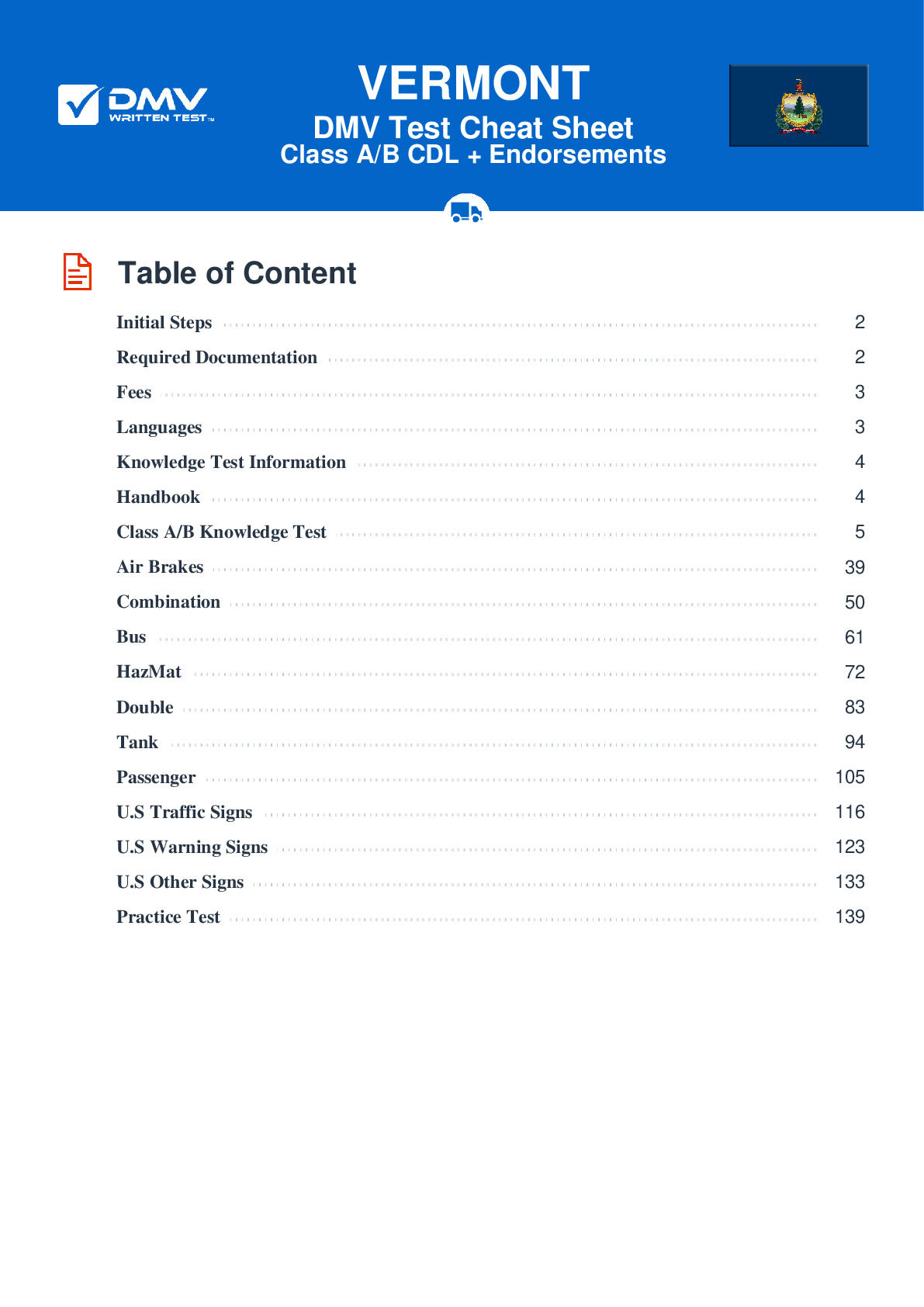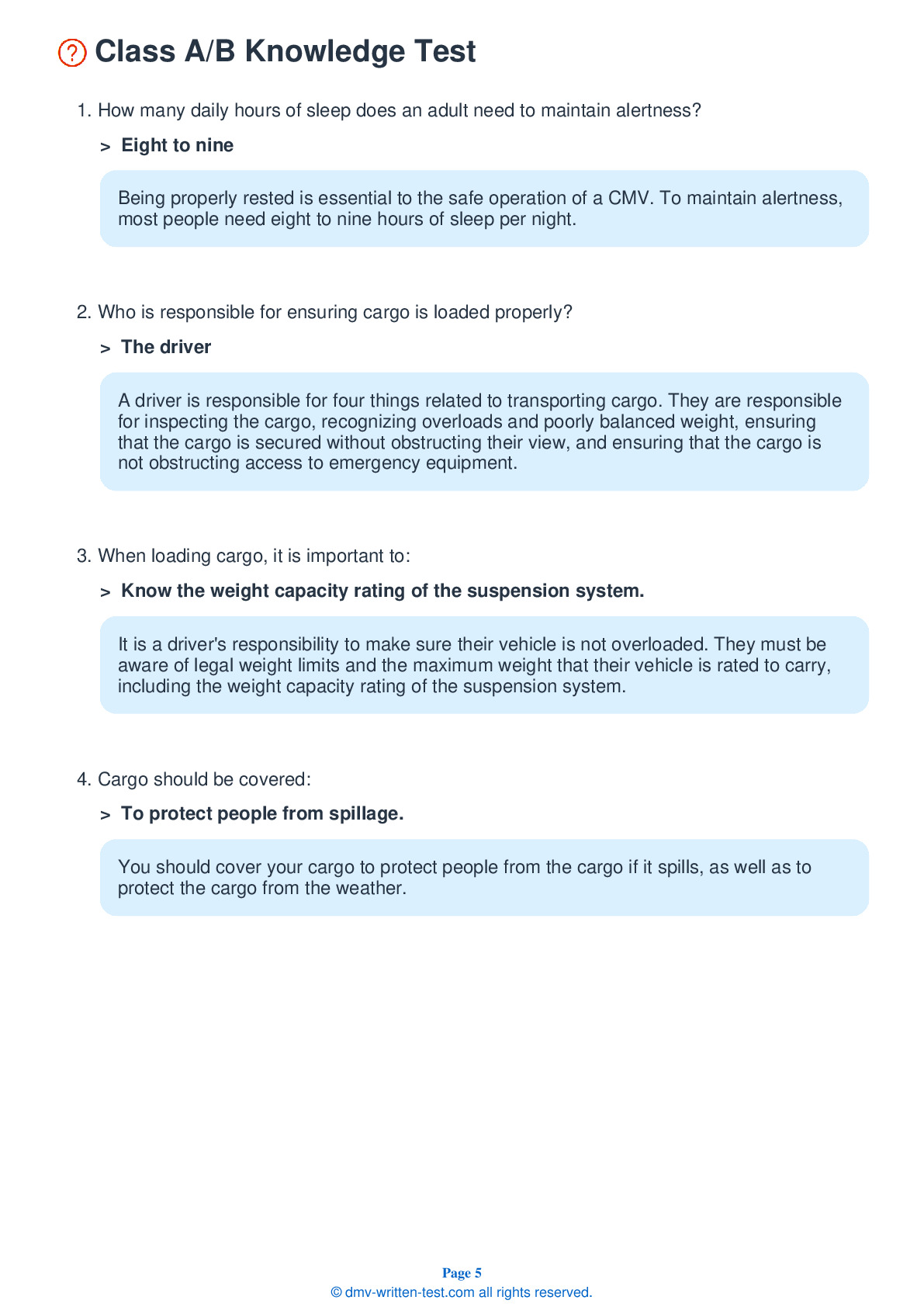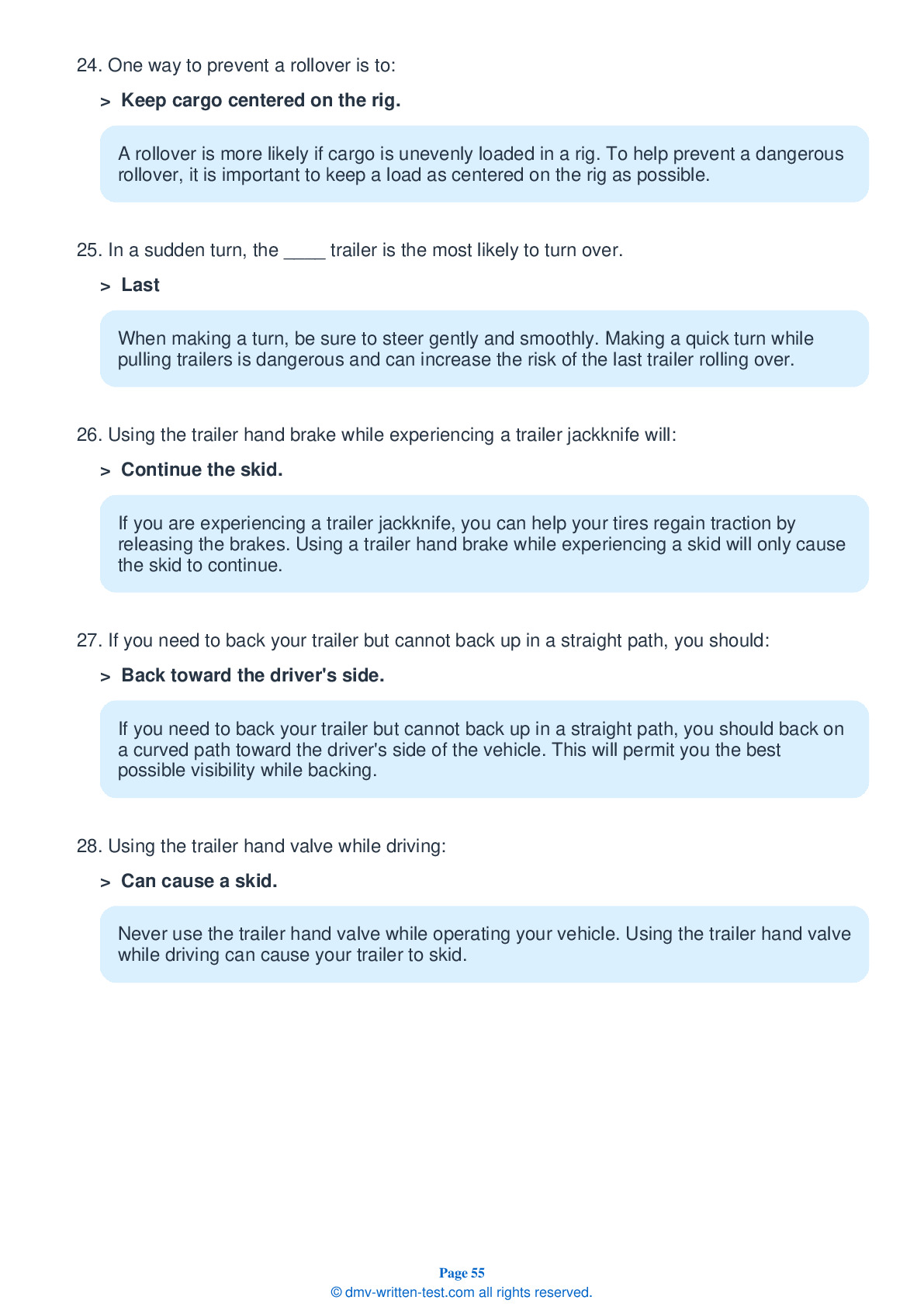Knowledge Test Class B
This license is required for driving a single vehicle with a GVWR of more than 26,001 pounds, and a trailer not to exceed 10,000 pounds gross vehicle weight rating, or a vehicle designed to transport 24 or more people (including the driver). To receive this license, applicants must pass a 50-question test. To pass, applicants must answer 40 questions correctly. Each question has three possible answer choices. Test questions come from the Vermont Commercial Driver’s Manual. Questions come from chapters covering: Introduction, Driving Safely, Transporting Cargo Safely, Air Brakes (if applicable), Pre-Trip Vehicle Inspection Test, Basic Vehicle Control Skills Test and On-Road Driving.. Endorsements that may be used with a Class B CDL are: Hazardous materials, Tank, Passenger, HazMat and Tank, Air Brakes and School bus.
43. What should you do if your vehicle gets stuck on railroad tracks?
If your CMV gets stuck on railroad tracks, you should immediately leave the vehicle and get away from the tracks. Check the signposts or signal housing at the crossing for emergency contact information and call 911, or another appropriate emergency number.
44. You should maintain at least ____ of following distance per every 10 feet of your vehicle when you are traveling more slowly than 40 mph.
At speeds below 40 mph, you should allow at least one second of following distance for every 10 feet of your vehicle. Follow the same formula when traveling at faster speeds, then add one additional second to your following distance. Remember that larger vehicles require more space to stop than smaller vehicles.
45. When traveling down a steep grade, you switch into a lower gear:
You should shift your vehicle's transmission into a low gear before staring a downhill grade. Be prepared for gravity to increase your vehicle's speed when traveling downhill.
46. Interstate carriers must have what information affixed to both sides of a CMV?
Federal Motor Carrier Safety Regulations (FMCSR) require carriers to affix the USDOT number to both sides of each CMV in their fleet.
47. When doing a pre-trip inspection, you should:
Pre-trip inspections should be conducted in the same way every time. This will reinforce the steps, making it less likely that you will forget to inspect something important.
48. To avoid a collision with a hazard on the roadway:
Swerving out of the way of a hazard is sometimes safer than trying to stop before reaching the hazard. You can usually turn away from something more quickly than you can come to a complete stop.
49. Wheel rims that have been welded should:
Wheels or rims that have had welding repairs are not safe to be used.
50. Who is responsible for the safe operation of a vehicle?
The person driving a vehicle is responsible for its safe operation. Be sure to perform routine vehicle inspections before operating a commercial motor vehicle.
Frequently Asked Questions
To obtain a Class B CDL in Vermont, here are the steps you need to follow:
1. Obtain a Vermont Commercial Learner's Permit (CLP) by passing a written knowledge test specific to the class of vehicle you want to drive.
2. Hold the CLP for at least 14 days before scheduling a road skills test.
3. Schedule and pass a road skills test in a Class B vehicle with the Vermont Department of Motor Vehicles (DMV). This test will assess your ability to safely operate the vehicle and perform maneuvers such as backing up, turning, and parking.
4. Provide proof of identity and residency, as well as pass a medical examination and pay the necessary fees.
5. Upon passing all necessary tests and meeting all requirements, you will be issued a Vermont Class B CDL.
1. Straight trucks: These are vehicles that have one frame and one rear axle, such as delivery trucks, dump trucks, and cement mixers.
2. Buses: This includes any vehicle designed to transport 16 or more passengers, including school buses, transit buses, and motor coaches.
3. Combination vehicles: These are vehicles that consist of a tractor unit towing one or more trailers or semi-trailers.
It's important to note that additional endorsements may be required to operate certain types of vehicles, such as hazardous materials (HazMat) or passenger endorsements for certain types of buses.
1. Age: You must be at least 18 years old to obtain a Class B CDL, or 21 years old if you plan to operate a commercial vehicle across state lines or transport hazardous materials.
2. Hold a valid Vermont driver's license.
3. Obtain a Vermont Commercial Learner's Permit (CLP) by passing a written knowledge test specific to the class of vehicle you want to drive.
4. Meet the medical requirements by passing a medical examination and obtaining a Medical Examiner's Certificate.
5. Hold the CLP for at least 14 days before scheduling a road skills test.
6. Schedule and pass a road skills test in a Class B vehicle with the Vermont Department of Motor Vehicles (DMV). This test will assess your ability to safely operate the vehicle and perform maneuvers such as backing up, turning, and parking.
7. Provide proof of identity and residency, as well as pay the necessary fees.
8. Pass any additional endorsements required for certain types of vehicles, such as hazardous materials (HazMat) or passenger endorsements for certain types of buses.
It's important to note that prior to obtaining a CDL, you must have a clean driving record with no serious traffic violations or DUI convictions.
- Transport passengers for hire (this includes school buses and other types of buses)
- Transport hazardous materials
- Operate a commercial vehicle outside of Vermont
If you are between 18 and 20 years old and want to obtain a Class B CDL, you will need to comply with these restrictions until you turn 21 years old. After turning 21, these restrictions will be lifted, and you will be able to operate all types of commercial vehicles and transport any type of cargo.
The most common endorsement for a Class B CDL is the passenger endorsement (P). This endorsement is required if you plan to operate a vehicle designed to transport 16 or more passengers, including the driver.
Another common endorsement for a Class B CDL is the hazardous materials endorsement (H). This endorsement is required if you plan to transport hazardous materials, which are defined by the U.S. Department of Transportation as any substance or material that could pose a risk to public safety or the environment when transported.
Other endorsements that may be required for a Class B CDL include:
- Tanker endorsement (N): Required if you plan to operate a vehicle that carries liquids or gases in bulk containers with a capacity of 1,000 gallons or more.
- School bus endorsement (S): Required if you plan to operate a school bus.
- Doubles/triples endorsement (T): Required if you plan to operate a combination of two or three trailers.
To obtain any of these endorsements, you will need to pass additional knowledge and skills tests specific to each endorsement.
1. Pre-trip inspection: You will be asked to perform a thorough inspection of your vehicle to ensure that it is safe to operate. You will need to identify and explain any defects or malfunctions you find.
2. Basic vehicle control: You will need to demonstrate your ability to control the vehicle in various situations, such as backing up, turning, and parking. You will also need to show that you can perform specific maneuvers, such as straight-line backing and alley docking.
3. On-road driving: You will need to demonstrate your ability to operate the vehicle safely on public roads. The examiner will evaluate your ability to obey traffic laws, make turns, change lanes, and navigate intersections.
During the skills test, the examiner will be looking for a number of specific skills and behaviors, including:
- Proper use of mirrors and turn signals
- Smooth acceleration and braking
- Safe and effective shifting (if applicable)
- Proper use of clutch (if applicable)
- Proper lane positioning
- Safe following distance
- Awareness of surroundings and potential hazards
To pass the Class B CDL skills test in Vermont, you must successfully complete all three parts of the test with a score of 80% or higher. Additionally, you must have a valid medical certificate and pass a background check.
1. Vehicle weight: Drivers with a Class B CDL are limited to operating vehicles with a gross vehicle weight rating (GVWR) of 26,001 pounds or more. This includes single vehicles or combinations of vehicles, such as a truck and trailer.
2. Passenger restrictions: If you do not have a passenger endorsement (P), you are not allowed to operate a vehicle designed to transport 16 or more passengers, including the driver.
3. Hazardous materials: If you do not have a hazardous materials endorsement (H), you are not allowed to transport any materials that are considered hazardous by the U.S. Department of Transportation.
4. Air brakes: If you do not have an air brake endorsement, you are not allowed to operate any vehicle equipped with air brakes.
5. Time limitations: Drivers with a Class B CDL are subject to federal and state regulations regarding maximum driving time and mandatory rest periods.
It's important to note that these restrictions and limitations may vary depending on the specific circumstances of your situation. If you have any questions or concerns about your Class B CDL license in Vermont, it's always best to consult with your local Department of Motor Vehicles (DMV) or a qualified CDL instructor.
To take the written test in a language other than English, you will need to bring an interpreter with you who is fluent in both English and your chosen language. The interpreter must be at least 18 years old and cannot be a family member or anyone who has a vested interest in your passing or failing the test.
It's important to note that even if you take the written test in a language other than English, you will still need to demonstrate your ability to read and understand English by taking a separate English proficiency test. This test consists of reading and understanding highway signs and signals, as well as basic instructions written in English that are related to the operation of a commercial vehicle.
If you have any questions or concerns about taking the Class B CDL written test in Vermont, it's always best to consult with your local DMV or a qualified CDL instructor.
To request accommodations for the CDL written test due to a disability, you will need to contact the Vermont DMV's Driver Improvement and Control Division. You will be required to provide documentation of your disability and a description of the type of accommodation you need. The DMV will review your request and determine what accommodations can be provided.
Examples of accommodations that may be provided include additional test time, a separate testing area, or a reader to assist with reading questions aloud. Other accommodations may also be provided based on your specific needs.
It's important to note that you should make your request for accommodations as soon as possible, as it may take some time for the DMV to review and approve your request. If you have any questions or concerns about requesting accommodations for the Class B CDL written test in Vermont, it's always best to consult with your local DMV or a qualified CDL instructor.
If you fail the written test, you will typically be required to wait a certain period of time before you can retake it. In Vermont, you must wait at least one day before retaking the test. If you fail the test three times, you will be required to wait at least 30 days before retaking it again.
When you retake the written test, you will be required to pay the testing fee again. It's important to note that you will be given a different version of the test each time you take it, so it's important to study and prepare thoroughly before each attempt.
If you continue to fail the written test after multiple attempts, it may be a sign that you need additional training or study materials. You may want to consider working with a qualified CDL instructor or taking a CDL training course to improve your chances of passing the written test.
In summary, if you fail the Class B CDL written test in Vermont, you can retake it after waiting at least one day. However, if you fail three times, you will be required to wait at least 30 days before retaking it again.




